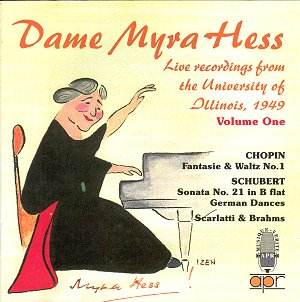Myra Hess hated recording. In that she was hardly unique
but even amongst musicians of her generation the disparity between studio
and live recordings is extreme. The first in a three CD conspectus of
her live American recordings from the University of Illinois in 1949
is therefore a valuable opportunity to appreciate more fully the exploratory
and frequently more galvanized responses of the pianist in the, to her,
more human arena of a concert hall.
Hess recorded little Chopin commercially. By 1949 her
discography boasted only the op.15/2 Nocturne, a recording dating from
1931 (itís on Pearl GEMM CD9462). The existence of the op.49 Fantasie
and the op.18 Waltz is therefore doubly outstanding; all the more so
as it reveals aspects of her playing either subsumed or only hinted
at elsewhere. Her Chopin is unexpectedly fiery. The Fantasie is a tour
de force of romantic expressivity with some truly thunderous playing
aided by some pretty liberal pedalling; the effect is to my ears over
intense and, whilst not out of control, at least unconstrained. But
what canít be denied is the passionate conviction of it, its enveloping
and declamatory fervour. If you think of Hess from her commercial discs
as an adept and discreet performer, elfin and reserved, with patrician
restraint, then start here and prepare to be disabused. The Schubert
Sonata receives a good performance. It lacks precisely those qualities
of insight and revelation that mark the greatest traversals but in its
gemutlich way it is commendably well played, with convincing articulation,
though never really probing much beneath the musicís surface.
The Dances are another matter. This thirteen-minute
confection comprises German Dances, Waltzes and Ländler and is
inimitably introduced by Hess herself. She plays them with such mastery
of tone and timing, such thoughtful playfulness and with such evident
enjoyment and energy that they are simply irresistible. The Brahms and
Scarlatti were staples of her concert giving life and every bit as good
as one would expect.
APRís production standards are exceptionally high.
A delicious caricature of Hess on the cover is complemented in the booklet
itself by a turn of the century portrait of the young pianist, demure,
modest, head cast down in profile. Marshall Izen has penned the affectionate
notes, which are common to all three volumes of the series. There are
some problems with the sound Ė some wavery moments of flutter and some
drop-outs Ė but nothing remotely off-putting, given the scarcity of
the source material and the amount of work that has gone to presenting
it to us now. A splendid start to a major series and unreservedly recommended.
Jonathan Woolf


